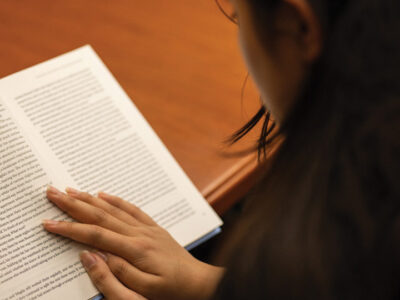
Addressing climate change before time runs out.
“What if the climate crisis were a medical emergency?” asked Simon Richter, Penn’s Class of 1942 Endowed Term Professor of German, during a short but impassioned outdoor talk in September. Speaking to a crowd assembled on College Green, he was joined by sophomores Brea Watkins and Kimberlie Dupiton to deliver a 1.5 Minute Climate Lecture, titled “The Climate Patient’s Bill of Rights.” A new spin on the School of Arts and Sciences’s 60-Second Lecture series, the 1.5 Minute Climate Lectures were delivered by faculty and students on the theme of climate change. At the podium, Richter, Watkins, and Dupiton imagined a scenario in which humans are “stage 4 climate patients” and offered a prescription for the University.
“Set up a task force to establish guidelines to reduce air travel,” said Watkins.
“Eliminate plastics [in Penn’s] dining and catering services,” offered Dupiton.
“We need a center for climate action with an academic mission,” noted Richter.
A total of 20 lectures given over the span of four weeks showcased a variety of perspectives, providing a glimpse of how Penn’s own research informs our view of the climate crisis and can offer solutions. Topics ranged from the deleterious effects of modern agriculture, to a new category of mourning called ecological grief, to the first notion of global warming in 1896, to contemporary shortages of clean drinking water.
Gary Bernstein, the Reese W. Flower Professor of Astronomy and Astrophysics, provided a 25,000-light-year perspective in “An Astrophysicist’s View of Earth’s Climate.” Frederick Steiner GRP’77 GFA’86 Gr’86, dean of the Stuart Weitzman School of Design and Paley Professor, offered landscape design suggestions in “Plant Trees Strategically and Wisely.” Michael Weisberg, professor and chair of philosophy, pondered predictions of the future in “How Do We Know How Bad It Will Get?”
“The climate emergency concerns everyone,” says Richter, who formulated the idea for the project and organized it with Paul Sniegowski, dean of the College of Arts and Sciences and professor of biology. Every discipline and function of the University plays a role, “from dining, to air travel, to curriculum, you name it.”
But a drive to inform students was a major catalyst for the idea, Richter says. “I’ve often seen the faces of students as they register the full extent of the crisis and what it will mean for their lives. They’re horrified, as they should be.”
Says Sniegowski, “Those of us entrusted with educating young people have a duty to tell what we know about global warming.” Older adults won’t be around to see the worst effects, he notes, but students will. “As an institution of learning, it’s Penn’s responsibility to inform the community about the causes and consequences of climate change, and to advocate for the changes this emergency requires.”
So why 1.5 minutes? The United Nations Intergovernmental Panel on Climate Change states that 1.5 degrees Celsius is the maximum amount the earth’s temperature can rise in order to avoid the worst effects of global warming. “We’re already past one degree Celsius,” warns Sniegowski.
Adds Richter, “Every lecture is actually two minutes long in order to illustrate how difficult it is to remain below 1.5.”
The climate emergency requires the attention of the entire Penn community, Richter says. “Penn has wonderful institutions like the Kleinman Center, the Penn Program in Environmental Humanities, and the Penn Eco-Reps program. But they serve and inform only a self-selecting fragment of the Penn population.” The 1.5 Minute Climate Lectures literally bring the issue out in the open—in front of the Ben Franklin statue, and promulgated on social media and the internet. —NP
All of the climate lectures are available at web.sas.upenn.edu/climate-1point5.




